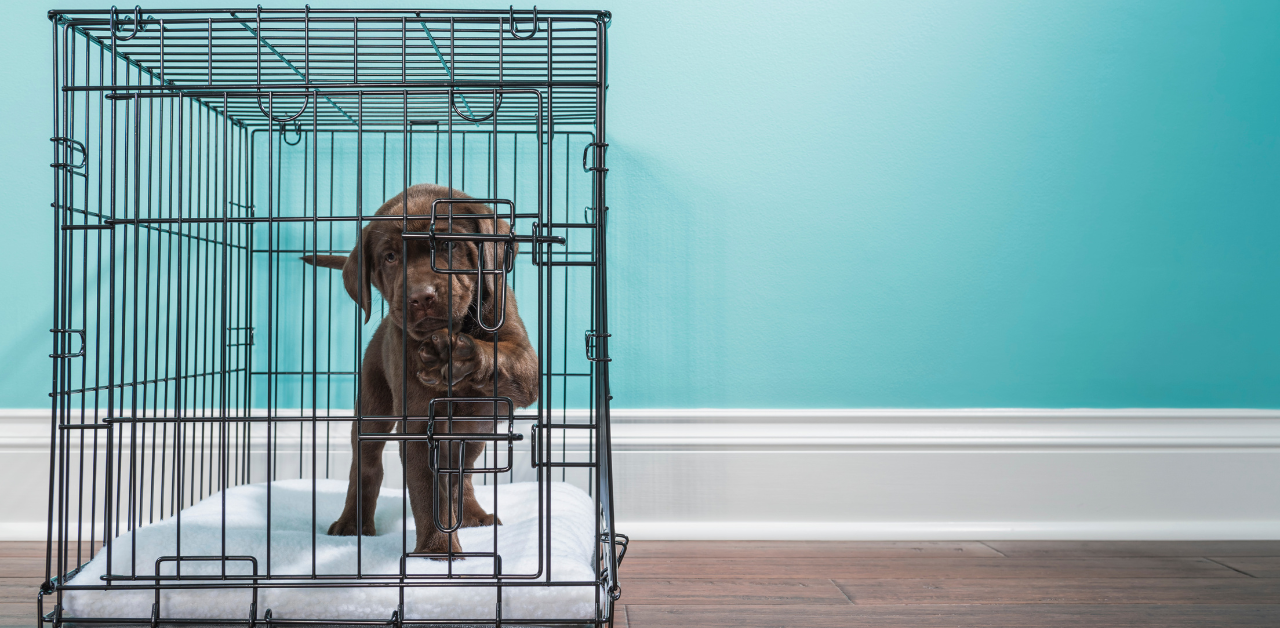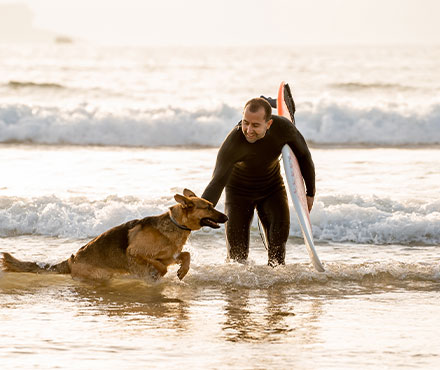The 10 Best Labrador Retriever Puppy Crates, Pens & Gates

Bringing home a Labrador Retriever puppy is exciting, but it comes with its own set of challenges. One of the first hurdles? Finding the perfect space for your new pup to feel safe and secure. Without the right crate, pen, or gate, your little bundle of energy might just turn your home into a playground or, worse, a chew toy.
You want your puppy to feel comfortable yet contained. But with so many options, choosing the best one can be overwhelming. Crate training is essential, but picking the right size or type can lead to satisfaction for both you and your dog.
So, what’s the solution? We've narrowed down the 10 best Labrador Retriever puppy crates, pens, and gates to help you find the right fit for your furry friend. Whether you need a sturdy metal crate with a secure latch, a soft-sided crate for easy transport, or a pen for puppy training, our list has something for every dog owner.
List of 10 Best Puppy Crates, Pens & Gates for Labrador Retriever
When selecting crates, pens, and gates for Labrador Retriever puppies, various options are designed to provide safety, comfort, and containment. Here are 10 of the best options across these categories:
1. Petmate Ultra Vari Kennel

- Type: Crate
- Key Features:
- Durable plastic construction with steel wire doors
- Ventilation on sides for airflow
- Meets most airline cargo specifications
- Ideal for travel or home use
2. Frisco Fold & Carry Double Door Dog Crate
- Type: Crate
- Key Features:
- Double doors for convenience
- Sturdy metal construction
- Includes a divider panel, plastic base, and handle for portability
- Affordable and highly rated by pet owners
3. EliteField 3-Door Folding Soft Dog Crate
- Type: Crate
- Key Features:
- Soft-sided and lightweight for easy transport
- Three doors for easy access
- Well-ventilated with mesh panels
- Ideal for travel or indoor use
4. New World Folding Metal Dog Crate
- Type: Crate
- Key Features:
- Single or double-door options
- Foldable for storage
- Durable and rust-resistant metal
- Secure slide-bolt latches for safety
5. Ruffmaxx Camo Kennel

- Type: Crate
- Key Features:
- Durable plastic dog crate construction with steel wire door
- Camouflage design for outdoor enthusiasts
- Ventilation on sides for adequate airflow
- Ideal for both home and travel use
- Sturdy and secure, perfect for outdoor adventures
6. Regalo 192-inch Super Wide Adjustable Baby Gate and Play Yard
- Type: Gate/Playpen
- Key Features:
- Can be used as a play yard, gate, or barrier
- Made of sturdy steel with a walk-through door
- Configurable design to fit various spaces
- Folds for easy storage
7. MidWest Homes for Pets Dog Crate
- Type: Crate
- Key Features:
- Double-door design for easy access
- Divider panel to adjust the crate's size as your puppy grows
- Durable, easy-to-clean plastic pan
- Foldable for easy storage and transport
8. Carlson Pet Products Convertible Pet Yard
- Type: Playpen/Gate
- Key Features:
- Functions as a play yard or a gate
- Easy to convert between configurations
- Sturdy metal construction
- Walk-through door for easy access
9. PawHut Large Outdoor Dog Kennel
- Type: Outdoor Kennel
- Key Features:
- Spacious for outdoor use
- Made with galvanized steel for durability
- Comes with a waterproof cover for protection against the elements
- Secure latch on the door for safety
10. MidWest Exercise Pen
- Type: Playpen
- Key Features:
- Made of durable metal wire
- Available in different heights to suit growing puppies
- Includes ground anchors for outdoor use
- Easy to fold and store
Choosing the Right Size Crate
Selecting the right size crate for your dog is key to ensuring their comfort, safety, and well-being. Whether you're crate training a new puppy or providing a secure space for your adult dog, the right crate size makes a difference.
1. Consider Your Dog's Size and Breed
When choosing a crate, start with your dog's size and breed. For example, Labrador Retrievers need more space than smaller breeds. If you're looking for the best Labrador Retriever puppy crates, pens, and gates, ensure the crate offers enough room for your dog to stand, turn around, and lie comfortably. A metal crate with a sturdy frame or a wire crate is an excellent option for larger breeds. For smaller breeds, soft-sided crates or plastic crates might be more suitable.
2. Think About Growth
If you have a growing puppy, consider getting a crate with an adjustable divider. This way, you can increase the space as your puppy grows. Buying a larger crate immediately is tempting, but more space can help with potty training. A crate that’s too big might encourage your puppy to use one end as a bathroom, which isn't ideal for crate training.
3. Different Types of Crates
Crates come in various materials, each with its benefits.
- Wire crates offer good ventilation and visibility, making them popular for crate training. They also fold flat, making storage easy.
- Plastic dog crates are lightweight, provide a den-like feel, and are great for travel or for dogs who prefer more privacy.
- Wooden dog crates can double as furniture, blending seamlessly with home decor.
- Chew-proof metal crates are for dogs that love to chew. A crate with a secure door latch is a smart choice.
4. Ensuring Comfort and Safety
Your dog's crate should be safe, not just a holding pen. Make sure the crate has a removable tray or pan for easy cleaning. Rubber feet on the bottom can prevent slipping and protect your floors. For added comfort, include a crate mat or bedding, and ensure the crate has a secure latch to prevent escapes.
Double doors can provide flexibility in placement, and a sturdy design ensures the crate withstands wear and tear. If your dog suffers from separation anxiety, make the crate a cozy, inviting space with toys or a blanket to help them feel secure.
5. Measure Your Dog
To get the correct crate size, measure your dog from the tip of the nose to the base of the tail and from the top of the head to the floor. Add a few inches to both measurements to ensure enough space for your dog to move comfortably. For adult dogs, choose a crate that matches their current size. For puppies, consider their potential adult size.
Tips for Crate Training Labrador Puppies
Crate training is an essential part of raising a Labrador Retriever puppy. A properly used dog crate prevents accidents, keeps the puppy safe from harmful objects, deters destructive behavior, and provides a safe space to retreat. A dog crate can also be used for potty training. Dogs have an instinct to avoid soiling their living area.
Here are practical tips for effective crate training to create a positive and safe environment for your Labrador puppy. These include introducing the crate and the importance of a consistent routine.
- Allow your puppy to explore the crate independently, rewarding them when they enter it willingly.
- Treats and praise can help create a positive association with the crate, making it a welcoming and safe place for your puppy.
- Establishing a consistent routine helps your Labrador puppy associate their crate with safety and comfort, which is necessary during house training.
- Avoid using the crate as a form of punishment to prevent negative feelings towards it.
- Regularly scheduled bathroom breaks are recommended for reinforcing potty training.
Safety Features to Look For in Crates and Pens
Safety features are of utmost importance when selecting a crate or pen for your Labrador Retriever puppy. A well-constructed crate or pen should feature a sturdy frame that can withstand the strength of energetic puppies, ensuring their security. Additionally, secure latch mechanisms are essential to prevent accidental openings and escapes.
In this section, we will discuss two key safety features to look for: a secure door latch and a sturdy frame. These features are crucial for ensuring the safety and well-being of your Labrador puppy.
Secure Door Latch
A secure door latch prevents your puppy from escaping their crate. A reliable lock mechanism significantly reduces this risk. For example, the Frisco wire dog crate features a solid locking mechanism ensuring security.
A single-door dog Crate also has three reinforced latches and rounded edges for added safety.
Sturdy Frame
A sturdy frame is crucial for a crate to withstand the energy and activity of a growing Labrador puppy. Metal frames with welded joints enhance bending and damage resistance, ensuring the crate’s longevity. A stable frame also prevents the crate from tipping over during your puppy’s movements, contributing to their safety and comfort.
Maintaining and Cleaning Your Puppy’s Crate

Maintaining and cleaning your Labrador Retriever puppy’s crate is essential for their health and hygiene. Choosing a crate with a removable tray simplifies cleaning and maintenance tasks, allowing quick and easy cleanup after accidents. Utilizing crate liners and washable bedding can also make cleaning easier by protecting the crate from spills and messes.
Here are tips for maintaining and cleaning your puppy’s crate. Regular maintenance and thorough cleaning are crucial for a clean and comfortable environment.
Removable Tray
The primary benefit of having a removable tray in a dog crate is the ease of cleaning after accidents. A plastic tray is designed to catch waste and spills, making it easy to maintain hygiene by allowing pet owners to remove and clean up messes quickly.
This feature ensures convenience and cleanliness for pets and owners, making it an important consideration when selecting a crate.
Regular Maintenance
Maintaining your puppy’s crate is essential to keep it tidy and hygienic. Spot cleaning should be done frequently to remove any immediate messes, while deep cleaning is recommended at least once a month.
Using mild dish soap mixed with warm water is an effective method for cleaning the crate's interior. Then, disinfect it with a suitable cleaning spray and let it sit for a few minutes.
Ensure Safety and Comfort for Your Labrador Retriever Puppy
Choosing the correct crate, pen, or gate for your Labrador Retriever puppy is essential for their safety, comfort, and training. With a wide range of options available—from plastic dog crates to wire crates and even stylish wooden furniture—you can find the perfect fit for your puppy's needs. Whether you need a crate for potty training, managing separation anxiety, or providing a safe space for your growing puppy, it's important to consider factors like size, durability, and ease of use.
Looking for premium pet supplies and accessories, including top-quality dog crates? Shop online at Petmate today. Your pet deserves the best, and Petmate is ready to help you find exactly what you need, all from the comfort of your home.
Related posts
View all-

Activities To Do With A Dog That Loves Water
Some dog breeds seem to be happy to play in the water all day if you let them. For these pups, there are plenty of summer activities that will keep them entertained. Here are examples you can do with a dog that loves to splash and play in the water. Read Article -

How to Get My Cat to Use His Scratching Post
Many cats prefer scratching furniture over a post, leaving their owners frustrated with shredded sofas and clawed-up carpets. But don’t worry—getting your cat to use a scratching post instead of your couch is possible with the right approach.
Read Article -

How to Get My Cat to Stop Using My Chairs as Scratching Posts
If your cat is turning your dining chairs into their personal scratching post, you’re not alone. Many cats scratch furniture, and while it’s frustrating, it’s also completely normal. Scratching isn’t just about sharpening their claws—it’s how cats stretch, mark their territory with scent glands, and relieve stress.
Read Article





